The journey of a plum, from plant to punnet
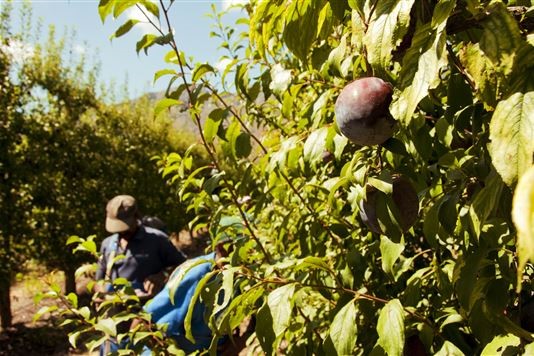
A plum travels over 6,000 miles and goes through nearly a dozen stages to get from its mother tree to your fruit bowl. Here we follow the journey of a plum, from a South African tree to British kitchen.
I was in South Africa last month, researching their fruit and wine industry, and spent much of my week on baking hot plum farms. The humble plum and other stone fruits (especially peaches and nectarines) are of vital importance to South Africa’s struggling post-Apartheid economy – a quarter of a million South Africans are employed in the deciduous fruit industry, which has thankfully grown by 63% since 2009.
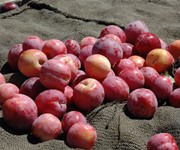 South African plums are in season from November through to the end of March, and varieties include: Laetitia (an orange-yellow flesh plum, with a melting texture and bright red skin); African Delight (a dark red-purple coloured skin plum, with a yellow flesh and a sweet taste); African Pride (a yellow flesh plum, with a fine texture and a bright yellow skin); and the heavenly (though rare) Pluot, which is made by crossing an apricot with a plum.
South African plums are in season from November through to the end of March, and varieties include: Laetitia (an orange-yellow flesh plum, with a melting texture and bright red skin); African Delight (a dark red-purple coloured skin plum, with a yellow flesh and a sweet taste); African Pride (a yellow flesh plum, with a fine texture and a bright yellow skin); and the heavenly (though rare) Pluot, which is made by crossing an apricot with a plum.
Growing and picking
So what’s the first stage of the plummy process? Growing the trees, of course. You have to be a patient sort to farm fruit – it takes nine years to break even on a plum tree (that is, nine years until the fruit from one tree generates enough income to outweigh the original cost of the plant). It's an even longer 12 years for an apple tree.
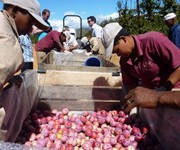 Let’s fast forward nine years, and imagine a whole grove full of thriving plum trees. The next thing to do is pick the fruit. When the plums are bordering on ripe, the farmer employs seasonal workers to twist the fruit from their branches – the twisting method limits the damage you might do to the fruit. I watched the process at Babylonstoren, an old Cape Dutch farm producing 12 varieties of plums, which pays each worker according to how many plums he/she can gather in a day. The best picker might fetch 300 Rand, or just over £16, for eight hours' work. Because their pay is related to their speed, a picking workforce is always furiously frantic… woe betide anyone who gets in their way.
Let’s fast forward nine years, and imagine a whole grove full of thriving plum trees. The next thing to do is pick the fruit. When the plums are bordering on ripe, the farmer employs seasonal workers to twist the fruit from their branches – the twisting method limits the damage you might do to the fruit. I watched the process at Babylonstoren, an old Cape Dutch farm producing 12 varieties of plums, which pays each worker according to how many plums he/she can gather in a day. The best picker might fetch 300 Rand, or just over £16, for eight hours' work. Because their pay is related to their speed, a picking workforce is always furiously frantic… woe betide anyone who gets in their way.
All in a day
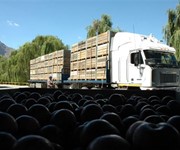 The pickers carefully throw their plums into trailers attached to a little tractor, which chugs them away from the fields and towards a fleet of lorries. A short trip later, and the freshly picked plums arrive at a packing house such as Franschhoek Fruit Packers, a fruit export company based near Cape Town. The aim is to accept the plum delivery, pack the fruit, chill the fruit, transport the fruit to Cape Town harbour, and send the fruit on its way, all in the space of one day. Of course, such a strict timescale is not always possible. Employee Ilze Botha, who took us around the factory, said that it was “always a race to get the whole process done in a day; exports tend to only take place towards the latter part of the week, so if a fruit delivery comes in on, say, a Monday, it can be tricky.”
The pickers carefully throw their plums into trailers attached to a little tractor, which chugs them away from the fields and towards a fleet of lorries. A short trip later, and the freshly picked plums arrive at a packing house such as Franschhoek Fruit Packers, a fruit export company based near Cape Town. The aim is to accept the plum delivery, pack the fruit, chill the fruit, transport the fruit to Cape Town harbour, and send the fruit on its way, all in the space of one day. Of course, such a strict timescale is not always possible. Employee Ilze Botha, who took us around the factory, said that it was “always a race to get the whole process done in a day; exports tend to only take place towards the latter part of the week, so if a fruit delivery comes in on, say, a Monday, it can be tricky.”
Testing time
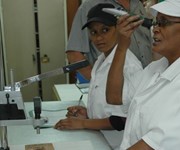 As soon as the plums arrive at the packing house, a small sample is taken to be tested – if those choice plums pass the test, then the whole lorry-load is deemed OK for packing. Variables such as the plum’s sugar content and its ‘pressure’ are measured, the latter of which gives an indication of how ripe the fruit is. Ideally, a plum should measure 5kg in pressure at the point of export, and 3kg in pressure at the point of eating. So you certainly don’t want anything less than 5kg in pressure at the packing stage.
As soon as the plums arrive at the packing house, a small sample is taken to be tested – if those choice plums pass the test, then the whole lorry-load is deemed OK for packing. Variables such as the plum’s sugar content and its ‘pressure’ are measured, the latter of which gives an indication of how ripe the fruit is. Ideally, a plum should measure 5kg in pressure at the point of export, and 3kg in pressure at the point of eating. So you certainly don’t want anything less than 5kg in pressure at the packing stage.
The spitting machine
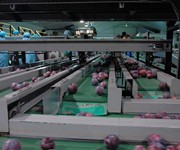 Once those various tests have been passed, all the plums can be put through the packing process. It’s basically a huge, Wallace & Gromit-style conveyor belt, which ‘spits’ plums out at various stages according to their size… the Chinese market, for example, likes its stone fruit large, whereas we Brits prefer petite plums. Once the plums are in size-appropriate sections, a gaggle of workers (99.9% of which are women) sift through the fruit, checking for and disposing of any plums which are damaged, oddly shaped, or otherwise out of line with the status quo. The plums are lightly brushed when on the conveyor built, but they’re never actually washed, which is why it’s so important to rinse supermarket fruit before you eat it.
Once those various tests have been passed, all the plums can be put through the packing process. It’s basically a huge, Wallace & Gromit-style conveyor belt, which ‘spits’ plums out at various stages according to their size… the Chinese market, for example, likes its stone fruit large, whereas we Brits prefer petite plums. Once the plums are in size-appropriate sections, a gaggle of workers (99.9% of which are women) sift through the fruit, checking for and disposing of any plums which are damaged, oddly shaped, or otherwise out of line with the status quo. The plums are lightly brushed when on the conveyor built, but they’re never actually washed, which is why it’s so important to rinse supermarket fruit before you eat it.
Boxing and checking
 The successful plums are then boxed by hand, and are sometimes individually decorated with a sticker, again by hand. Next, they’re transferred by forklifts to a chilled room, set at about -0.5°C (a medicinal place to be, when you’ve been wilting in a 35°C field for the past hour).
The successful plums are then boxed by hand, and are sometimes individually decorated with a sticker, again by hand. Next, they’re transferred by forklifts to a chilled room, set at about -0.5°C (a medicinal place to be, when you’ve been wilting in a 35°C field for the past hour).
Then there is one final test for the plums to go through before they can be exported. The Perishable Products Export Control Board (PPECB) has an office inside every South African packing house, and an inspector will check for factors such as size, sugar content, freshness, traceability, markings and pressure. This precaution means that, once they’ve arrived in the EU, the plums won’t have to be checked again. And it’s perhaps one of the reasons why South African stone fruit is considered to be the best in the world – other producers such as Chile don’t have similar export standards to adhere to.
Sailing the seas
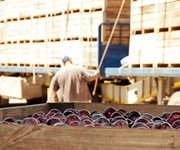 Finally, the exhausted plums are driven to giant ‘cooling centres’, where they’ll stay until it’s time to be transferred to Cape Town harbour (99% of South Africa’s fruit is shipped). As I mentioned in my first South African diary piece, the boat trip to Britain is never longer than 14 days (compared to around 21 days for fruit from Chile, the next nearest southern hemisphere producer), and the fruit ripens naturally along the way. Obviously if left completely alone, the plums would be overripe by the time they reached British shores. Temperature, not chemicals, is therefore used to delay the process, and it must be strictly monitored throughout the journey. If a ship fails to maintain the required temperatures, then it alone is liable for any damage done to the fruit.
Finally, the exhausted plums are driven to giant ‘cooling centres’, where they’ll stay until it’s time to be transferred to Cape Town harbour (99% of South Africa’s fruit is shipped). As I mentioned in my first South African diary piece, the boat trip to Britain is never longer than 14 days (compared to around 21 days for fruit from Chile, the next nearest southern hemisphere producer), and the fruit ripens naturally along the way. Obviously if left completely alone, the plums would be overripe by the time they reached British shores. Temperature, not chemicals, is therefore used to delay the process, and it must be strictly monitored throughout the journey. If a ship fails to maintain the required temperatures, then it alone is liable for any damage done to the fruit.
Your fruit bowl
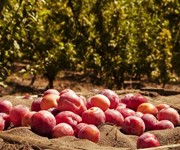 Once in the UK (South Africa also exports to Asia and the rest of Europe), the plums make their way to various shops and supermarkets (25% of the cost of a punnet of plums goes to the grower), hoping to be picked up by someone like you. They should be near-ripe when you get them home, and after a couple of hours in a sunny spot, they’ll be ready for eating. So the next time you bite into the juicy flesh of a perfect plum (and remember, South African stone fruit is in season during our wintertime), spare a thought for what it’s gone through to reach your mouth!
Once in the UK (South Africa also exports to Asia and the rest of Europe), the plums make their way to various shops and supermarkets (25% of the cost of a punnet of plums goes to the grower), hoping to be picked up by someone like you. They should be near-ripe when you get them home, and after a couple of hours in a sunny spot, they’ll be ready for eating. So the next time you bite into the juicy flesh of a perfect plum (and remember, South African stone fruit is in season during our wintertime), spare a thought for what it’s gone through to reach your mouth!
You might also like
Comments
Do you want to comment on this article? You need to be signed in for this feature